
The La Tène culture was a European Iron Age culture. It developed and flourished during the late Iron Age, succeeding the early Iron Age Hallstatt culture without any definite cultural break, under considerable Mediterranean influence from the Greeks in pre-Roman Gaul, the Etruscans, and the Golasecca culture, but whose artistic style nevertheless did not depend on those Mediterranean influences.

A hillfort is a type of earthwork used as a fortified refuge or defended settlement, located to exploit a rise in elevation for defensive advantage. They are typically European and of the Bronze Age or Iron Age. Some were used in the post-Roman period. The fortification usually follows the contours of a hill and consists of one or more lines of earthworks, with stockades or defensive walls, and external ditches.If enemies were approaching the civilians would spot them from a mile away.
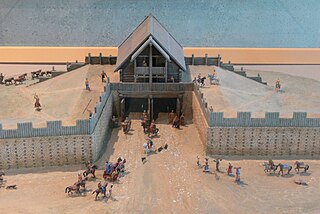
An oppidum is a large fortified Iron Age settlement or town. Oppida are primarily associated with the Celtic late La Tène culture, emerging during the 2nd and 1st centuries BC, spread across Europe, stretching from Britain and Iberia in the west to the edge of the Hungarian plain in the east. These settlements continued to be used until the Romans conquered Southern and Western Europe. Many subsequently became Roman-era towns and cities, whilst others were abandoned. In regions north of the rivers Danube and Rhine, such as most of Germania, where the populations remained independent from Rome, oppida continued to be used into the 1st century AD.

Bibracte, a Gallic oppidum, was the capital of the Aedui and one of the most important hillforts in Gaul. It was located near modern Autun in Burgundy, France. The material culture of the Aedui corresponded to the Late Iron Age La Tène culture.

Alcimoennis or Alkimoennis is the name widely attached to a Celtic Oppidum, or hill fort above the modern town of Kelheim in Bavaria, Germany. The name comes from Ptolemy, who in his Geography, only mentioned the name and described the location of the settlement. There is some controversy over the identification of the Kelheim remains with Alcimoennis, but it is still widely accepted.

Castro culture is the archaeological term for the material culture of the northwestern regions of the Iberian Peninsula together with the Spanish regions of Galicia, Asturias, and western León) from the end of the Bronze Age until it was subsumed by Roman culture. It is the culture associated with the Gallaecians and Astures.
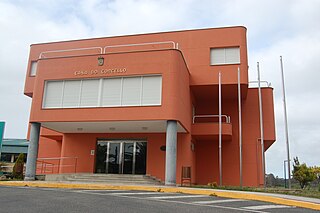
Cabana de Bergantiños or Cabana is a municipality in the Province of A Coruña, in the autonomous community of Galicia in northwestern Spain. It used to be known as Cesullas.

Cambre is a municipality in the Province of A Coruña, in the autonomous community of Galicia in northwestern Spain. It is located 12 km from the capital city of A Coruña and ten minutes away from the city's airport, Alvedro.

Carballo is a municipality in the north western region of Spain in the province of A Coruña, in the Autonomous community of Galicia, Spain and seventeenth overall in the country. It belongs to the Comarca of Bergantiños.

Titelberg is the site of a large Celtic settlement or oppidum in the extreme south west of Luxembourg. In the 1st century BCE, this thriving community was probably the capital of the Treveri people. The site thus provides telling evidence of urban civilization in the century before the Roman conquest.

The Citânia de Briteiros is an archaeological site of the Castro culture located in the Portuguese civil parish of Briteiros São Salvador e Briteiros Santa Leocádia in the municipality of Guimarães; important for its size, "urban" form and developed architecture, it is one of the more excavated sites in northwestern Iberian Peninsula. Although primarily known as the remains of an Iron Age proto-urban hill fort, the excavations at the site have revealed evidence of sequential settlement, extending from the Bronze to Middle Ages.

Chao Samartín is a Castro located in the municipality of Grandas,. It was founded in the Bronze Age, around the year 800 BCE. The castro was discovered in 1977.
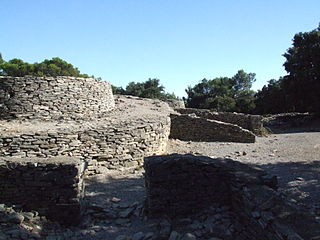
The Oppidum de Nages or Oppidum des Castels is on a hilltop overlooking the valley called the Vaunage, above the village of Nages-et-Solorgues, in Gard, between Nîmes et Sommières, in Occitanie, France. It is one of six iron-age oppida in the Vaunage, occupied between 800 BCE and 50 BCE. It has been listed since 1980 as a monument historique by the French Ministry of Culture.

Cuetlajuchitlán is a Mesoamerican archaeological site located 3 kilometers southeast of Paso Morelos, in the northeast of the Mexican state of Guerrero.
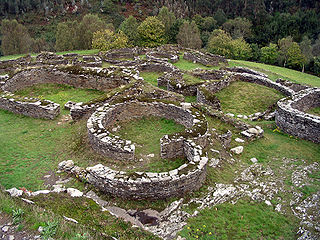
A castro is a fortified settlement, usually pre-Roman, some from late Bronze Age and Iron Age, associated with Celtic culture. These are frequently found in Northern Spain, particularly in Asturias, Galicia, Cantabria, Basque Country and the province of Ávila, with the Castro culture and on the plateau with Las Cogotas culture.

The Castro de Baroña is an Iron Age fortified settlement located in the parish of Baroña, a municipality of Porto do Son in the province of A Coruña. The settlement, surrounded by two walls and containing twenty roundhouses that still remain today, was built on a peninsula and inhabited from the 1st Century BC to the 1st Century AD.
Peñas de la Cerca is an Iron Age hillfort, in the province of Zamora, north-western Spain. It is near a hamlet called Rionegrito de Sanabria. Situated in a mountainous region on the north-western edge of the Northern Sub-Plateau, the site controls the middle of the Tera valley, between the natural shires of Sanabria and Carballeda (plateau).
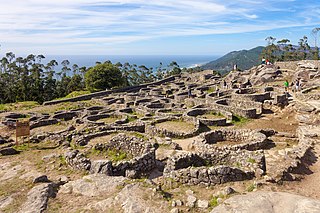
Castro of Santa Trega is an archaeological site located on the hillsides of Mount Santa Trega, in the southwestern Galician municipality of A Guarda, Spain. The site is strategically located overlooking the mouth of the river Miño, at 341 meters above sea level. Belonging to the Castro culture, it's one of the most emblematic and visited Galician forts (castros).

Florentino López Alonso-Cuevillas was a Spanish anthropologist and prehistorian, although in the course of his life he also became involved in writing, primarily essays and fiction. Like several other Galician intellectuals of his generation, he was a member of Xeración Nós, of the Seminar of Galician Studies and the Irmandades da Fala, combining the cultural and linguistic activities he carried out in those institutions with a discrete participation in pro-Galician politics. However, his social and political activities were profoundly disrupted by the victory of nationalists in the Spanish Civil War, although in the 1940s he returned to his commitment to the spread of Galician culture as a full member of the Royal Galician Academy, and of the Instituto de Estudios Gallegos Padre Sarmiento.

The Castro de Leceia or Leceia Eneolithic Station is an archeological site of the Castro culture located in the Portuguese civil parish of Barcarena in the municipality of Oeiras. The area was first occupied during the end of the Neolithic and throughout the Chalcolithic, being abandoned somewhere between the end of the 4th and the beginning of the 3rd millennium BCE. The Castro was first dug and reported in 1878 by Carlos Ribeiro, who presented his results to the Lisbon Academy of Sciences in what may be considered the first monograph dedicated to a pre-historical Portuguese settlement. The last interventions date to 2003. The site is classified as a public interest monument since 1963.




















